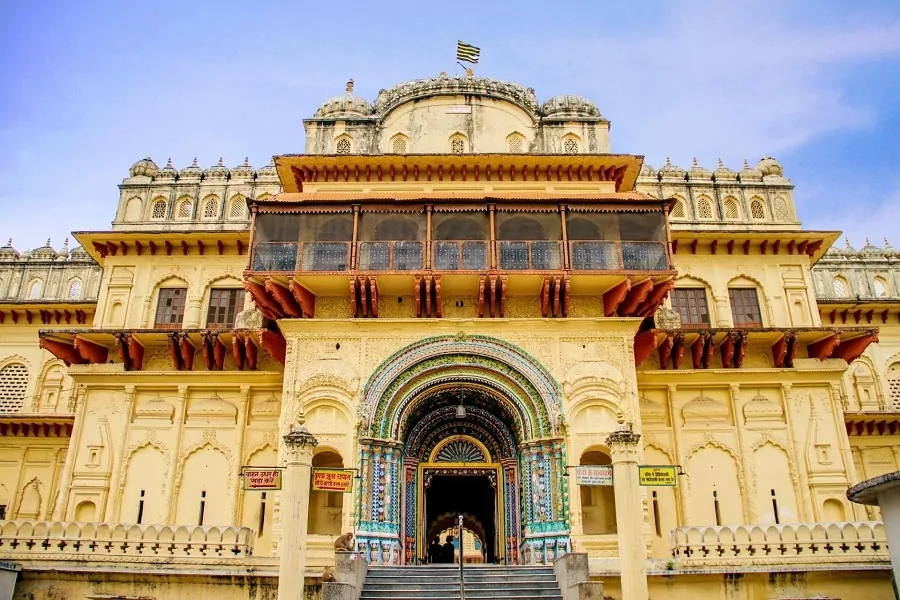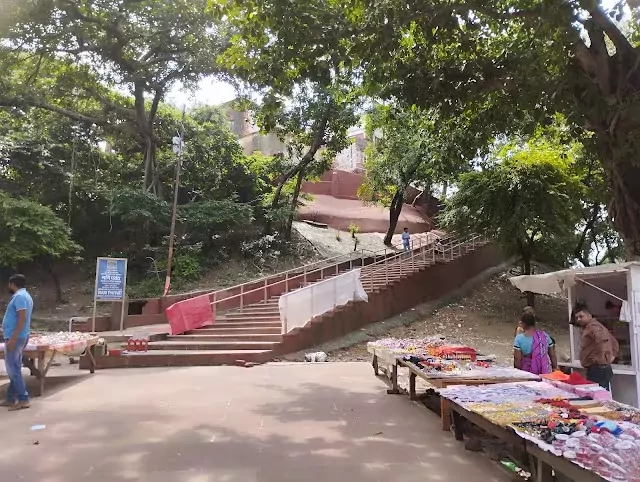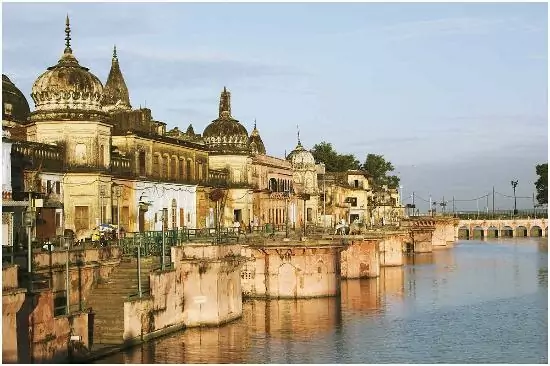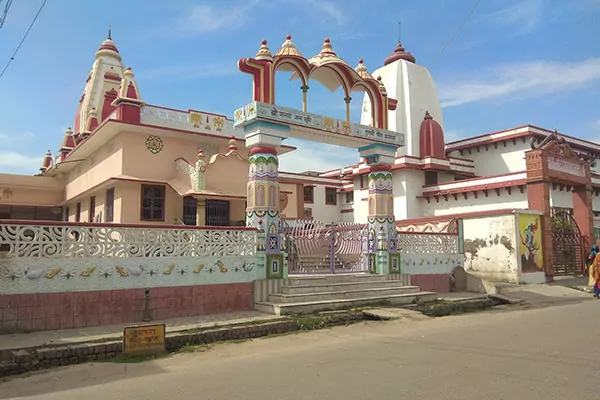Places to Visit in Ayodhya

Ramkot, Ayodhya
The primary place of worship in Ayodhya is Ramkot, situated on elevated ground in the city’s western area. Pilgrims visit year-round, but it’s particularly revered during ‘Ram Navami’ in the Hindu month of Chaitra (March-April), attracting devotees from across India and beyond to celebrate Lord Ram’s birth with grand festivities.

Kanak Bhawan, Ayodhya
Kanak Bhawan, also known as the Sone-ka-Mandir, is a stunningly adorned temple built in 1891 by Vrishbhanu Kuvari, Queen of Teekamgarh (Madhya Pradesh). The main temple encloses an open inner space where the sacred shrine of Rampada is located. Adorned with exquisite idols, including Goddess Sita and Lord Ram with his three brothers, the temple is a marvel to behold. These divine figures are adorned with golden crowns, adding to the temple’s splendor.

Hanuman Garhi, Ayodhya
Hanuman Garhi, shaped like a fort, stands at the town’s center, accessed by 76 steps. Legend says Hanuman guarded Ramkot here. The main temple houses Maa Anjani’s statue with Bal Hanuman. Devotees believe their wishes come true here. It’s Ayodhya’s top shrine, visited daily for blessings and protection.

Mani Parbat, Ayodhya
The 65-ft high Mani Parbat is believed to be a fragment of the hill carrying Sanjivini Booti, a healing herb, which fell as Hanuman transported it to Lanka to save the injured Lakhshman, Lord Ram’s brother. Some scholars suggest its Buddhist origins.

Nageshwar Temple, Ayodhya
The Nageshwar Temple, said to be founded by Kush, son of Rama, has a captivating legend. It’s believed that Kush lost his armlet in the Saryu River, retrieved by a Nag-Kanya who fell for him. As she was a Shiva devotee, Kush built this temple for her. Remarkably, this temple was the sole survivor during the time of Vikramaditya, amid the city’s ruins and dense forests. It played a crucial role in rediscovering Ayodhya’s sacred sites. Shivratri is celebrated here with grandeur.

Tulsi Smarak Bhawan, Ayodhya
Tulsi Smarak Bhawan pays homage to the revered saint-poet Goswami Tulsidas Ji. It hosts regular prayer gatherings, devotional concerts, and spiritual discussions. Additionally, it accommodates the Ayodhya Shodh Sansthan, featuring an extensive collection of literary works on Goswami Tulsidas. The Tulsi Smarak Auditorium stages Ramleela daily from 6:00 pm to 9:00 pm, drawing considerable attention.

Saryu River, Ayodhya
The Saryu River, a significant watercourse in Uttar Pradesh, is deeply rooted in ancient Hindu scriptures like the Vedas and Ramayana. Meaning ‘that which is streaming’, it gracefully flows through Ayodhya, believed to purify the city and cleanse impurities. Ram ki Pairi, the Saryu riverfront, boasts extensive ghats and gardens, adorned with a line of temples. Throughout the year, it draws hundreds of devotees seeking a sacred dip during various religious events.

Gurudwaras, Ayodhya
The gurudwaras situated in the Brahm Kund and Nazarbagh areas hold deep associations with Guru Nanak Dev Ji, Guru Teg Bahadur Ji, and Guru Govind Singh Ji.

Gulab Bari, Ayodhya
Gulab Bari, known as the rose garden, stands as one of the town’s most exquisite green spaces. Encompassing a vast area of lush greenery, the complex is home to the mausoleum of Shuja-ud-daulah, the 3rd Nawab of Awadh, and his parents. Adorned with a magnificent dome and enclosed by a surrounding wall, the splendid mausoleum features two grand gateways. Landscaped in the 18th century, the garden dazzles visitors with its diverse array of colorful roses.

Bahu Begam Maqbara Ayodhya
Bahu Begum Maqbara is the tomb of Begum Unmatuz Zohra Bano, the queen of Nawab Shuja-ud-Daula, showcasing exquisite Awadhi architectural style. This protected site, under the Archaeological Survey of India (ASI) and managed by the Shia Board Committee (Lucknow), is enveloped in lush greenery. It springs to life during Muharram. From the top of the complex, visitors can enjoy a panoramic view of the city, as it stands tall as one of Ayodhya’s highest structures.

Kichhauchha Sharifmaqbara Ayodhya
Kichhauchha Sharif Maqbara in Ayodhya is renowned for the shrine of the esteemed Sufi Saint Saiyad Makhdhum Shah Jahangir Asharfi. Born in Semnan, Iran, he significantly contributed to the Chishti lineage’s development. His teachings of peace spread far and wide, attracting pilgrims from all over. The Dargah Sharif, situated atop a small hill surrounded by a pond, boasts intricate marble, tile, and glass decorations. Throughout the year, thousands of devotees, both from India and abroad, pay homage to the revered saint at this sacred site.

Guptar Ghat Ayodhya
Guptar Ghat, situated along the banks of the River Saryu, is believed to be the location where Lord Rama performed Jal Samadhi. Constructed by Raja Darshan Singh in the early 19th century, the ghat boasts a series of well-maintained structures. Atop the ghats, visitors can find the Sita-Ram Temple, Chakrahari, Guptahari shrines, and the Narasingh Temple.

Samarth Saheb Siddhadas Dham Hargaon Ayodhya
Samarth Saheb Siddhadas Dham in Hargaon, Ayodhya, is linked to Sahib Dhulan Das Dharmee Dham in Rai Bareli district. Siddhadas, previously Ram Piyare Pathak, was a devoted disciple of Swami Jagjeevan Das Kotwadham, known as a messenger of the Satnam community. Born in 1845 in Sultanpur district, he sought spiritual guidance and received Gurumantra from Dulan Das. After twelve years of dedicated service, he earned the title of Exclusive Servant and God Devotee, becoming renowned as Siddhadas.
